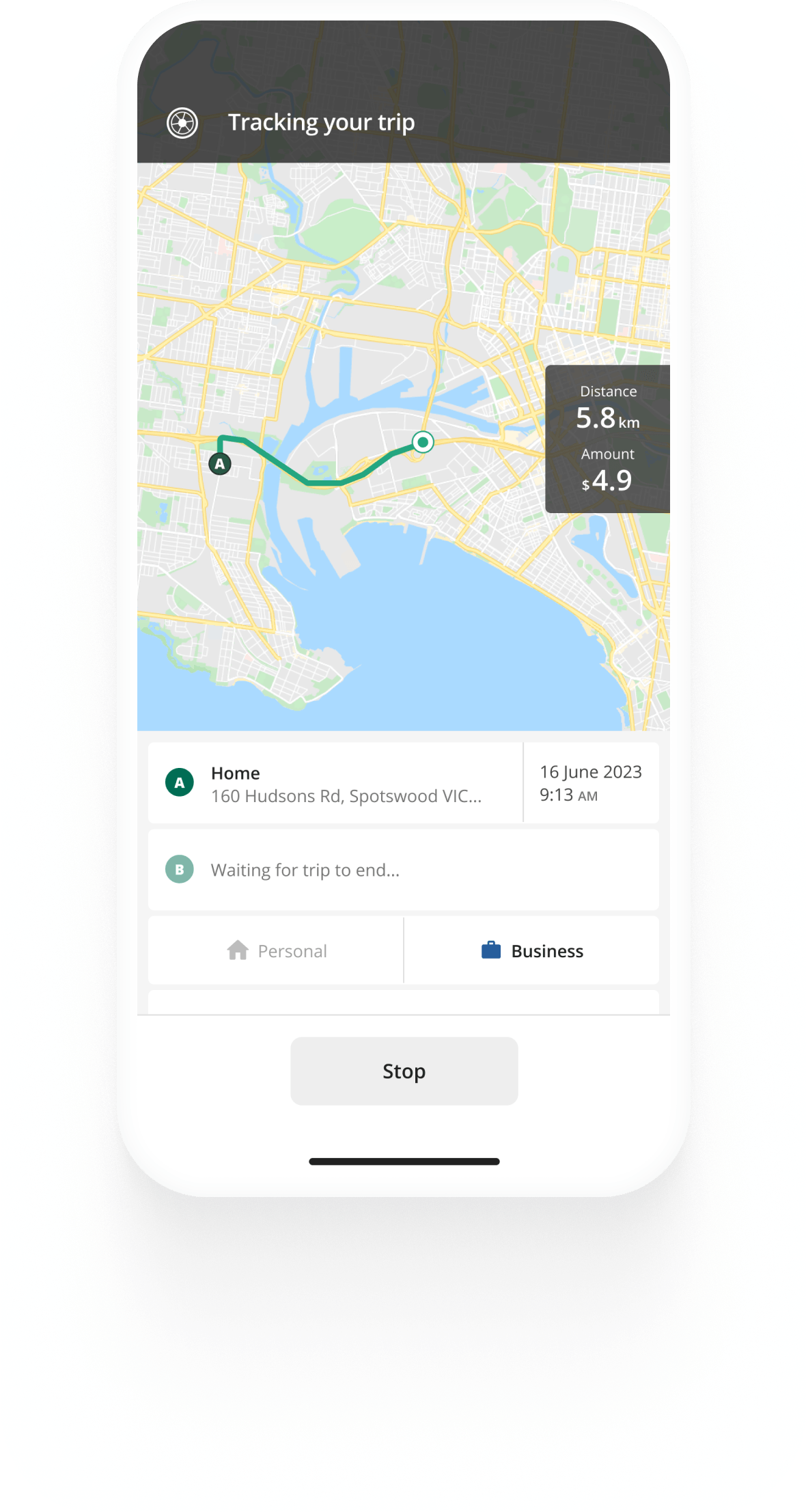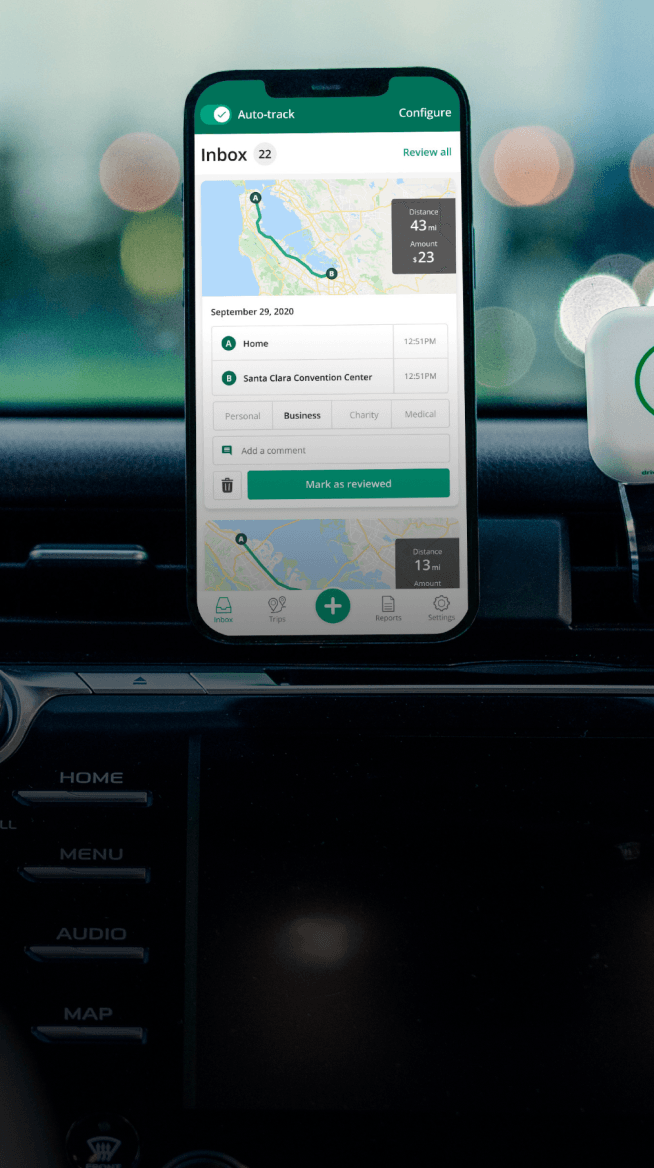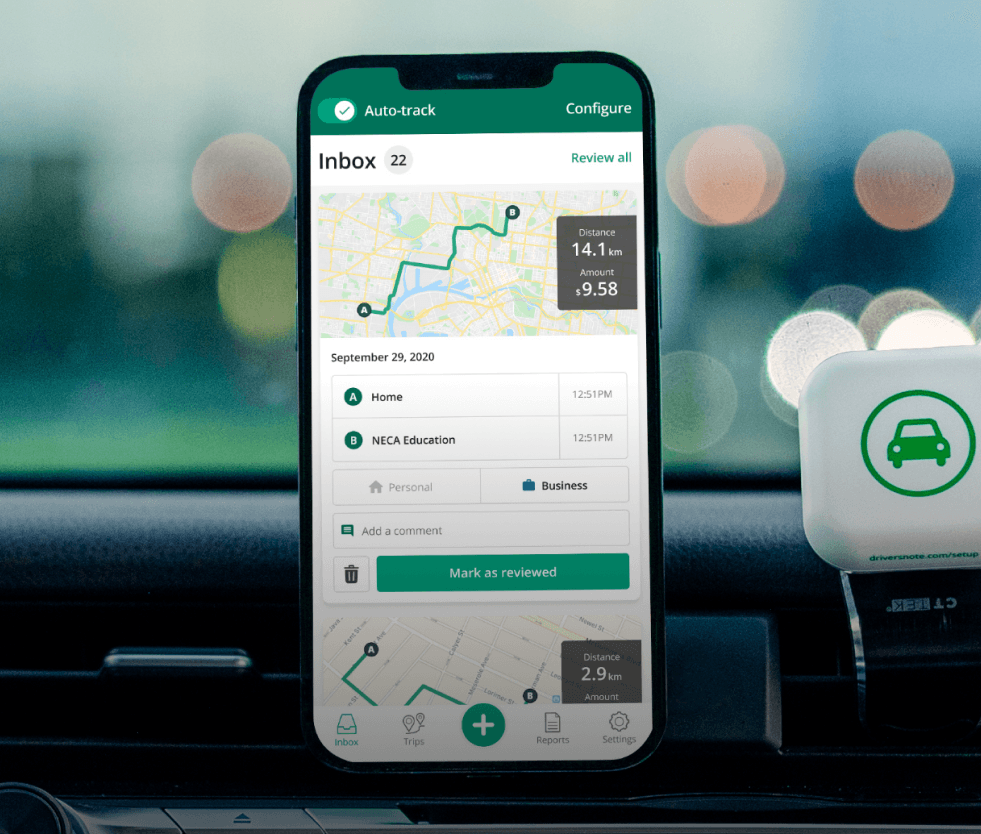Track mileage automatically
Get started
Guide to Car Allowance in Australia: What Employers Really Need to Know!
In this article
- Understanding car allowance
- Business benefits of offering a car allowance
- What's a fair car allowance in Australia?
- What types of expenses should a car allowance cover?
- Car allowance tax implications for the business
- Implement a car allowance scheme that everyone understands
- Document the car allowance scheme in a simple written policy
- FAQ
- Understanding car allowance
- Business benefits of offering a car allowance
- What's a fair car allowance in Australia?
- What types of expenses should a car allowance cover?
- Car allowance tax implications for the business
- Implement a car allowance scheme that everyone understands
- Document the car allowance scheme in a simple written policy
- FAQ
Are you considering offering your employees a car allowance but are unsure how it will affect your company's tax obligations or reporting requirements?
Keep reading to find out what you need to know, including why introducing a company mileage tracking solution might be worth it, even if it's not required by the Australian Taxation Office (ATO).
If you're an employee looking for guidance on car allowances, we recommend reading our blogs: Work-related Car Expenses for Employees and Car Allowance Guide for Employees.
Understanding car allowance
Before we get into the ins and outs of car allowance for employers, let's just get the "What is" out of the way.
A car allowance is a regular fixed amount, such as a monthly payment, that you provide to employees to compensate them for using their personal vehicles for work purposes.
Unlike reimbursing specific costs, a car allowance isn't necessarily tied to the actual expenses an employee incurs. As a result, it is considered taxable income for the employee, and the employer must report it through Single Touch Payroll (STP).
Also read: Car Allowances vs. Company Cars


Kilometre tracking made easy
Trusted by millions of drivers
Automate your logbook Automate your logbook

Automatic mileage tracking and ATO-compliant reporting.
Get started for free Get started for freeBusiness benefits of offering a car allowance
Implementing a car allowance scheme can offer several practical and financial advantages for your business:
- It's a fair and transparent way to compensate employees for using personal vehicles for work.
- You avoid the admin and costs of managing a company car fleet.
- You don't need to deal with the car Fringe Benefits Tax (FBT) that applies to company cars used for private purposes.
- Helps attract and retain staff when included in a broader salary package.
- Provides flexibility in salary negotiations—offers a competitive total remuneration without the commitment of a company vehicle.
- Tax-deductible for the business when correctly reported, improving cost efficiency.
What's a fair car allowance in Australia?
So, how do you determine a fair car allowance for your business and employees? In Australia, the ATO has no guidelines for standard or fixed amounts for car allowances. Depending on the employee's role and average distance travelled, anything from AUD $10,000 to $20,000 per year is offered.
Rather than choosing a one-size-fits-all allowance, you should tailor it to business needs and employee circumstances. To do that, consider these key factors:
1. The Employee's Role
The nature of an employee's role directly influences how much they use their personal vehicle for work-related purposes.
For example, sales representatives, construction, or field service workers who regularly travel to clients or off-site locations will naturally incur more vehicle-related costs (fuel, wear and tear, servicing, etc.), justifying a higher allowance.
In contrast, office-based staff with minimal work travel requirements may require only a small allowance, or none at all.
2. Average distance travelled
The more business kilometres an employee drives, the more costs they incur—fuel, maintenance, servicing, and depreciation all scale with usage.
Suppose an employee frequently travels long distances for work. In that case, a higher car allowance may be appropriate to offset these expenses fairly.
3. Local cost of living
Geographic cost differences matter. Employees based in areas with higher fuel prices, insurance premiums, or maintenance costs may face increased out-of-pocket expenses.
Factoring this into your allowance structure helps ensure equity and adequacy across your workforce.
What types of expenses should a car allowance cover?
Besides considering the more individual circumstances, a reasonable allowance reflects the expected work-related portion of the employee's vehicle costs.
Common expenses to consider include:
- Fuel
- Servicing and maintenance
- Tyres
- Insurance premiums
- Registration and licensing
- Depreciation or finance costs
However, the company should only cover the expenses attributable to business-related driving.
For example, if 60% of Ann's driving is for work, the allowance should cover 60% of her total car-related costs. So, understanding the employee's role and average travel distance is essential.
|
Employee role + average distance travelled + business-related vehicle expenses = car allowance. |
Is a car allowance part of an employee benefits package?
Many employers include a car allowance in the total salary and benefits package. This can be useful during salary negotiations because it gives you the flexibility to offer a competitive form of compensation without the expense or logistics of providing a company vehicle.
Because car allowances are generally tax-deductible for businesses, they can deliver greater value to employees at a lower net cost to you. More on that shortly.
Car allowance tax implications for the business
A car allowance is considered a business expense. Your business can claim it as a tax deduction, like salary or wages.
Like other deductible expenses, car allowances reduce taxable income, helping to lower overall tax liability. The allowance must be paid regularly as part of the employee's salary package to qualify for a deduction.C
|
Car allowances are tax-deductible for your business, similar to wages or salary. Make sure you keep proper records and report them correctly through payroll. |
How do you report and deduct car allowances in your business?
Your accounts or payroll team must keep clear records of all car allowance payments and follow ATO guidelines. The allowance should be clearly listed as part of the employee's pay and reported correctly through Single Touch Payroll (STP).
In addition to reporting the allowance through STP, you must also withhold PAYG (Pay As You Go) tax since car allowances are treated as taxable income for the employee.
Let's say you pay your employee a $1,000 flat-rate car allowance:
- You withhold PAYG tax from that $1,000, just like with wages.
- When you run payroll, you report the $1,000 and the withheld tax through STP.
Reporting a car allowance: Two approaches, same tax outcome
The ATO clearly distinguishes between a reimbursement (paid after expenses are incurred) and an allowance (paid upfront to cover anticipated costs), and when it comes to reporting the allowance, you need to distinguish between two types of allowances:
1. Cents-Per-Kilometre (Allowance Type: CD)
- Used when: You pay based on actual business kilometres driven.
- Rate: ATO-set (e.g. 88c/km for 2025–26).
- Varies by period: Payment changes depending on the distance travelled.
- Example: Employee drives 1,200 km → you pay $1,056 → report as Type CD in STP.
2. Flat-Rate Car Allowance (Allowance Type: OD – "V1")
- Used when: You pay a fixed amount regardless of distance.
- It may cover both business and private use.
- Frequency: Often monthly or annually, included in salary or benefits.
- Example: You pay $1,000/month to a project manager → report as Type OD with "V1 – Private vehicle" in STP.
So even though the ATO classifies both as allowances, they're reported differently under STP. Confusing the two can lead to reporting errors. This guide focuses on the flat-rate allowance, but understanding both ensures you stay compliant and choose the setup that fits your business needs.
Also read: Mileage Reimbursement Rules for Employers.
Key differences between car allowance and mileage reimbursement
| Car Allowance | Cents Per Kilometre Reimbursement | |
|---|---|---|
|
Payment Basis |
Fixed amount, paid regularly |
Based on actual business kms (e.g. 88c/km, up to 5,000 km, 2025/2026 rate) |
|
Tax Treatment |
Taxable income; PAYG and STP reporting required |
Generally not taxable if within ATO limits |
| Records Needed |
Logbook or mileage app encouraged |
Maintain a logbook of work-related travel |
| Deductible for the business? |
Yes |
Yes |
Implement a car allowance scheme that everyone understands
Car allowance rules and tax can be confusing, so expect questions when introducing a scheme. Sorting out the basics upfront saves your payroll team time and helps staff meet ATO requirements with confidence.
Be clear on:
- Why does the company offer a car allowance
- Who is eligible
- What it covers
- How much is paid
- How employees need to document and report mileage
Clarity from the start makes implementation smoother for everyone.
The why: define the purpose
Let it be clear why the business is offering a car allowance. Is it a perk, or is it to fairly compensate employees for using their personal vehicles for work-related driving?
The who: set clear eligibility criteria
Not all roles require regular travel. Define who qualifies—typically field staff, sales representatives, or employees regularly visiting clients or job sites. Be consistent and avoid grey areas to prevent disputes down the line.
The how: choose the allowance structure
Decide on the format that suits your business:
- Flat-rate allowance – Easy to administer, but may not reflect actual usage.
- Cents per kilometre – More accurate, but requires reliable mileage tracking.
- Tiered allowances – Could be based on role seniority or expected travel distance.
Make sure whatever you choose is explained in writing and linked to business use.
The how much: calculate a fair amount
The allowance should reflect the real fuel, maintenance, insurance, and vehicle depreciation costs. It's also essential to tailor the amount to the employee's location, role, and typical business kilometres, as costs and usage can vary significantly.
Setting the allowance at a realistic level helps strike the right balance: avoiding overpayment (which increases the employee's tax liability) while ensuring they're not left out of pocket.
The where: clarify tax implications upfront
Let employees know the allowance is treated as taxable income by the ATO. A higher allowance doesn't mean a better deal—it could reduce their take-home pay if they can't claim enough deductions.
Employees can reduce their tax liability by claiming work-related vehicle expenses only if they have proper records.
Also read: How to Claim Car Expenses From The ATO in 5 Steps
Report correctly through payroll
Employers must report car allowances accurately.
- Cents per Kilometre Allowance: Report as 'Allowance Type - CD' when paying based on kilometres travelled for business purposes.
- Flat-Rate Allowance: Report as 'Allowance Type - OD' with the description 'V1' for allowances that may cover business and private use.
Accurate reporting ensures compliance with ATO requirements and assists employees in meeting their tax obligations.
Work out how to report STP Phase 2 allowances at the ATO website.
Document the car allowance scheme in a simple written policy
And now, finally! The (almost) last step in your efficient implementation process is documentation and communication!
Create a straightforward written policy that covers the following key points:
- Eligibility: Who qualifies for the car allowance?
- Allowance amount: How much is paid and how is it calculated?
- Payment schedule: How often is the allowance paid (typically monthly)?
- Employee responsibilities: For example, maintaining a logbook or using a mileage app.
- Tax and reporting: Obligations for both the employee and employer.
- Operational efficiency: How to streamline processes and minimise manual tracking.
Keep it short, accessible, and consistent across departments.
Supporting hassle-free record-keeping (even if you're not required to) will secure smooth operations
When you pay a car allowance using a flat rate, you're not required to collect employee mileage records because the payment isn't based on actual kilometres travelled. I
f an employee wants to claim work-related vehicle expenses from the ATO, the responsibility of tracking and documenting mileage and expenses falls on them.
That said, helping your team build good record-keeping habits can make a big difference.
Using a tool like Driversnote allows employees to:
- Automatically track trips on their phone
- Label each trip as business or personal
- Export reports for tax time or internal reference
For businesses, the Teams solution can help:
- Keep a central overview of work-related trips
- Cross-check allowance payments with trip data
- Review allowance amounts annually to ensure they still make sense.
Even though it's not a requirement, having structured trip records supports transparency, simplifies employee tax-time admin, and helps your business keep the allowance scheme fit for purpose. Check out our Teams solution now.
FAQ

Tired of logging mileage by hand?
Effortless. ATO-compliant. Liberating.
Top posts
- Sole Trader Tax Deductions: An Essential Guide
- Cars Exempt from FBT
- Company Car Policy: Complete Guide & Downloadable Template
Related posts
ATO Mileage Guide
Latest update: 23 June 2025 - 5 min read
Learn about the rules of reimbursing employees for their car expenses or deducting expenses as an employee or self-employed individual.
Sole Trader Tax Deductions: An Essential Guide
Latest update: 22 October 2025 - 5 min read
Maximise your income with our guide to sole trader tax deductions. Learn about deductible business expenses and how to claim them.
Cars Exempt from FBT
Latest update: 8 July 2025 - 5 min read
Types of cars exempt from Fringe Benefits Tax, together with exemption conditions and a list of popular models that qualify.

.svg)
